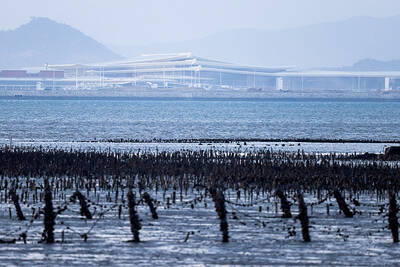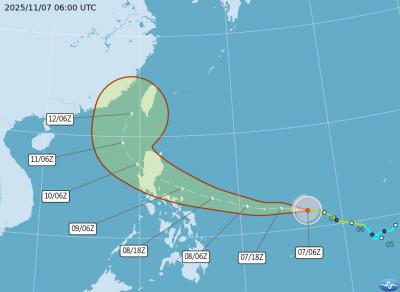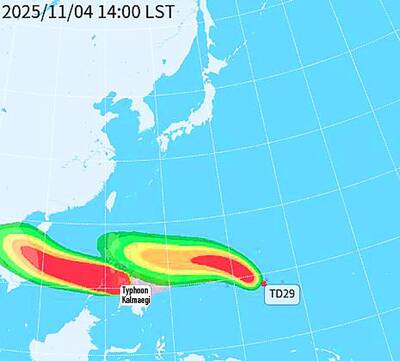The nation’s largest and the first government-funded live fish carrier vessel, Tai Hung 39, set out on its first voyage on Thursday from Taiwan to China.
The 276 tonne vessel, with a carrying capacity of 36 tonnes, which is five times that of traditional boats, is expected to help Taiwan increase its efficiency in exporting live fish, mainly grouper, to China.
An inauguration ceremony was held at the Cijin (旗津) fishing port in Greater Kaohsiung, where the vessel set sail, after scores of trucks carrying live grouper unloaded their cargoes onto the boat.
Council of Agriculture (COA) Minister Chen Wu-hsiung (陳武雄) said the government subsidized the building of the vessel to make live fish transport more efficient, as well as to save energy.
He predicted that the launch of Tai Hung 39 would help boost Taiwan’s grouper exports because the vessel boasts a larger carrying capacity, cuts the carrying cost by half and shortens transportation time, which ensures the freshness of the fish.
There are 18 live fish carrier vessels in Taiwan. Since most of these boats were converted from old fishing boats, the equipment on the boats needs to be upgraded, officials from the council’s Fisheries Agency said.
Officials said that Tai Hung 39 was specially designed to carry live fish and that its seawater circulation system, oxygen delivery efficiency and drainage functions were much better than those of traditional live fish carriers.
It is also equipped with a temperature control system seldom seen on live fish carriers that allows the water on the vessel to be kept at the best temperature for the fish, officials said.
Taiwan’s grouper exports have increased from 1,840 tonnes, worth NT$400 million (US$13.16 million), in 2008 to 7,958 tonnes, worth NT$2.4 billion, this year, the Fisheries Agency said.
Grouper prices have also risen from NT$292.6 a kilogram in 2008 to NT$400 a kilogram, the agency said.

UNILATERAL MOVES: Officials have raised concerns that Beijing could try to exert economic control over Kinmen in a key development plan next year The Civil Aviation Administration (CAA) yesterday said that China has so far failed to provide any information about a new airport expected to open next year that is less than 10km from a Taiwanese airport, raising flight safety concerns. Xiamen Xiangan International Airport is only about 3km at its closest point from the islands in Kinmen County — the scene of on-off fighting during the Cold War — and construction work can be seen and heard clearly from the Taiwan side. In a written statement sent to Reuters, the CAA said that airports close to each other need detailed advanced

Tropical Storm Fung-Wong would likely strengthen into a typhoon later today as it continues moving westward across the Pacific before heading in Taiwan’s direction next week, the Central Weather Administration (CWA) said. As of 8am, Fung-Wong was about 2,190km east-southeast of Cape Oluanpi (鵝鑾鼻), Taiwan’s southernmost point, moving westward at 25kph and possibly accelerating to 31kph, CWA data showed. The tropical storm is currently over waters east of the Philippines and still far from Taiwan, CWA forecaster Tseng Chao-cheng (曾昭誠) said, adding that it could likely strengthen into a typhoon later in the day. It is forecast to reach the South China Sea

WEATHER Typhoon forming: CWA A tropical depression is expected to form into a typhoon as early as today, the Central Weather Administration (CWA) said yesterday, adding that the storm’s path remains uncertain. Before the weekend, it would move toward the Philippines, the agency said. Some time around Monday next week, it might reach a turning point, either veering north toward waters east of Taiwan or continuing westward across the Philippines, the CWA said. Meanwhile, the eye of Typhoon Kalmaegi was 1,310km south-southeast of Oluanpi (鵝鑾鼻), Taiwan’s southernmost point, as of 2am yesterday, it said. The storm is forecast to move through central

Almost a quarter of volunteer soldiers who signed up from 2021 to last year have sought early discharge, the Legislative Yuan’s Budget Center said in a report. The report said that 12,884 of 52,674 people who volunteered in the period had sought an early exit from the military, returning NT$895.96 million (US$28.86 million) to the government. In 2021, there was a 105.34 percent rise in the volunteer recruitment rate, but the number has steadily declined since then, missing recruitment targets, the Chinese-language United Daily News said, citing the report. In 2021, only 521 volunteers dropped out of the military, the report said, citing